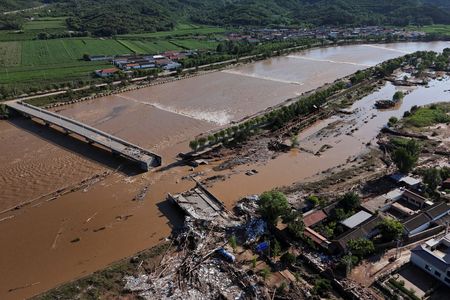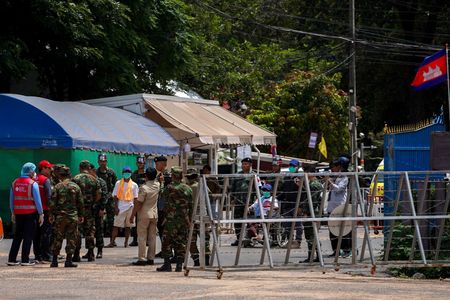By Liz Lee and Xiuhao Chen
BEIJING (Reuters) -Extreme rains and flooding across northern China have killed 60 people, more than half of them at a care home for the elderly in a suburb of Beijing, which has grappled with its deadliest flood disaster in years.
In Beijing, 44 people died over the past week, the city’s deputy mayor Xia Linmao said at a press conference on Thursday. At least 31 others were missing in the capital and neighbouring Hebei province, authorities said.
Torrential rains began a week ago and peaked around Beijing and surrounding provinces on Monday. In the space of a few days the hilly Miyun district in the northeast of the capital saw rainfall of up to 573.5 mm (22.6 inches). By comparison, the average annual precipitation in Beijing is around 600 mm.
Thirty-one people died at a nursing home in Miyun’s Taishitun, a town sitting immediately upstream from the Miyun reservoir and about a 90-minute drive from central Beijing.
Authorities were alerted about people trapped in the facility early on Monday, but rescue efforts were hampered by torrents of water in the streets, said Miyun’s top official, Yu Weiguo.
“The town centre where the nursing home was located had been safe for a long time, and was not included in the relocation plan,” Yu said during the press conference on Thursday.
“This showed that our contingency plan had flaws, and our understanding of extreme weather was inadequate,” said Yu, who was teary-eyed and wore black to the briefing.
A total of 69 elderly residents were at the nursing home when the floods hit, 55 of them with some form of functional impairment, authorities said. It was not clear if any staff at the home were among the dead.
The Miyun reservoir, the largest in China’s north, saw record-breaking water levels during the rains, which devastated nearby towns.
The Qingshui River, which runs through Taishitun feeding into the reservoir and is normally a small stream, was flowing at 1,500 times its normal volume on Monday morning when the disaster struck, Yu said.
The river’s peak flow was 2.3 times the previous record set more than a century ago, said Liu Bin, head of Beijing’s water authority.
In total, more than 300,000 people have been affected by the rain and flooding in Beijing, with more than 24,000 homes, 242 bridges and 756 km (470 miles) of roads damaged, deputy mayor Xia said, citing preliminary figures.
NEARBY REGIONS
In the nearby province of Hebei, 16 people died as a result of the intense rainfall.
At least eight were killed in the city of Chengde just outside Beijing, with 18 unaccounted for.
The deaths occurred in villages within the Xinglong area of Chengde in Hebei province, state-run Xinhua reported late on Wednesday. It cited local authorities but did not specify when or how the people died.
The villages border Miyun, sitting at higher elevations in a valley about 25 km (16 miles) from the Miyun reservoir.
In another Hebei village north of the reservoir, a landslide on Monday killed eight people and four were still missing.
Meteorologists link an increase in extreme weather events such as torrential rain and heatwaves to climate change.
In the summer of 2023, heavy rain killed at least 33 people in Beijing. A decade earlier in July 2012, 79 people died in the city in its deadliest flooding in living memory.
(Reporting by Liz Lee, Xiuhao Chen and Ryan WooEditing by Stephen Coates, Bernadette Baum and Frances Kerry)










